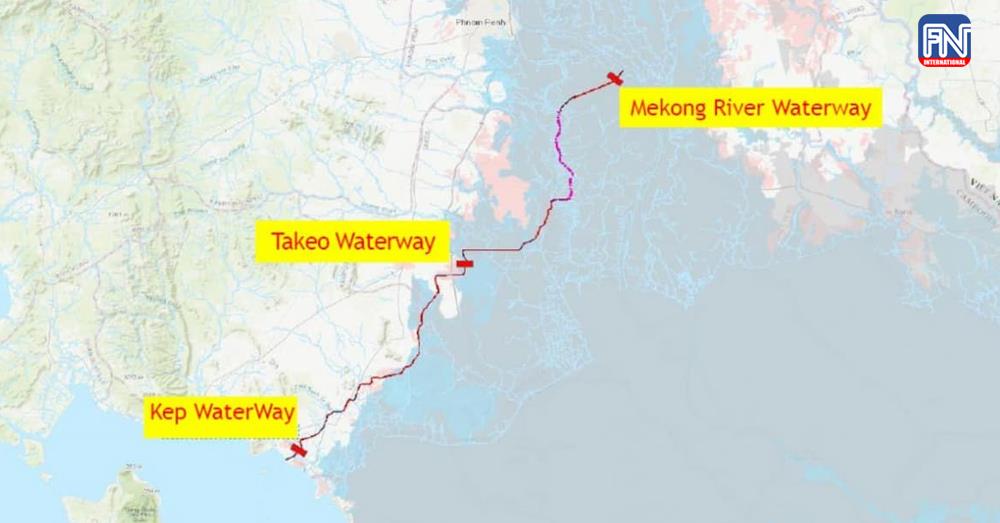Phnom Penh (FN), Dec. 12 – Cambodia, a nation rich in history, culture and natural resources, has long been a land of opportunities and untapped potential.
Over the past three decades, after gaining total peace in 1999, the country has been making strides towards economic growth and poverty reduction.
One of the most ambitious and transformative projects on Cambodia’s horizon is the Funan Techo Canal, a colossal endeavor that could reshape the country’s future.
Why is it named Funan?
Funan, an ancient state influenced by Indian culture and located in the Mekong Delta, flourished from the 1st to the 6th century AD. It featured an intricate network of canals linking its economic core to coastal regions, which together formed the main area of Funan. Angkor Borey was the hub of economic and cultural activities during this era. As such, Funan represents an example of economic and cultural interconnection.
Funan Techo Canal project can be regarded as Cambodia’s endeavor to transform itself to be the economic and cultural gateway of the Mekong.
The project was approved at the 6th Plenary Session of the National Assembly on 19 May 2023. On 7 June 2023, the government decided to establish an inter-ministerial commission to implement the project. On 17 October 2023, Cambodia signed an agreement to allow China Bridge and Road Corporation (CRBC) to conduct a feasibility study on the project.
Stretching 180 kilometers from the Takeo canal of the Mekong River to the coastal province of Kep, the canal traverses four provinces: Kandal, Takeo, Kampot, and Kep. This waterway is set to be a game-changer for Cambodia, and here’s why.
The Funan Techo Canal is designed to be a remarkable engineering feat. With a width of 100 meters upstream and 80 meters downstream, and a depth of 5.4 meters, it will accommodate two-way traffic and can carry ships with up to 3000DWT (Deadweight Tonnage). The canal is built to international standards, prioritizing safety and quality in its construction.
One of the notable aspects of this project is the thoroughness of the planning and the environmental considerations. A serious study was conducted by the government before project approval, taking more than two years of technical, legal, economic, environmental, and social studies and inter-ministerial consultations.
This comprehensive approach ensures that the canal will not only benefit the economy but also help preserve the ecology and environmental balance of the region. While it is acknowledged that some environmental impacts may occur during construction, measures will be taken to mitigate them.
The Funan Techo Canal is not just a grand infrastructure project; it’s a lifeline for approximately 1.6 million people living along its route. By facilitating efficient transportation and trade, it promises to bring economic opportunities to these communities.
The project aligns with Article 5 of the Mekong Agreement of 1995, which mandates that projects on tributaries of the Mekong River, including the Funan Techo Canal, must be subject to notification to the Joint Committee. Cambodia has duly complied with this requirement, demonstrating its commitment to regional cooperation and sustainable development.
The estimated cost of constructing the canal is a staggering USD 1.7 billion, a significant investment in Cambodia’s future. However, this investment is expected to yield substantial returns. The canal is projected to cut transport costs significantly, with savings of approximately USD170 for a 20-foot container and USD 223 for a 40-foot container, reducing transport costs by about 16%.
This will not only benefit businesses but also consumers, as lower transport costs can translate into more affordable goods.
The Funan Techo Canal is expected to boost the country’s fourth major economic center. This new development joins the ranks of existing three key economic regions: the first being Phnom Penh and its neighboring areas, known for their vibrant urban economy; the second is Sihanoukville along with its adjacent regions, noted for their strategic coastal economic activities; and the third is Siem Reap and its surrounding locales, renowned for their cultural and tourism-driven economy.
The economic internal rate of return, according to the study of the government, is calculated to be between 20% and 31%, indicating its potential for profitability and economic growth. The canal’s impact will extend beyond its immediate vicinity. It will promote the development of industrial zones, the formation of production lines, and supply chains, particularly in the agriculture and aquaculture sectors. Moreover, the canal will spur urbanization along the waterway, contributing to the development of what is being referred to as the fourth economic pole.
Clearly, the project will improve transportation networks and bring new opportunities to communities along its route. In this regard, relevant stakeholders, including the government, private sector, and local communities, must work together to ensure the Funan Techo Canal becomes a model of national and regional economic integration and connectivity as well as the promotion of inclusive, resilient and sustainable development.
Chheang Vannarith is President of the Asian Vision Institute (AVI) and Founder and Chairman of Angkor Social Innovation Park (ASIP).
This article was first published on Khmer Times.
=FRESH NEWS
